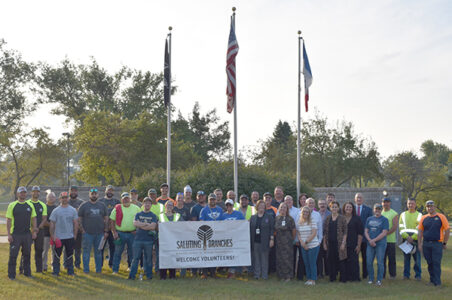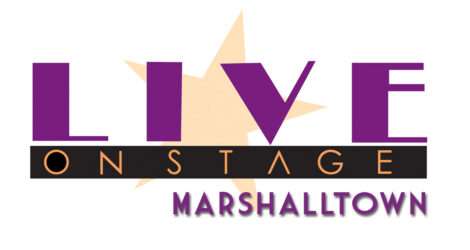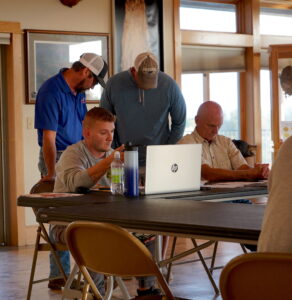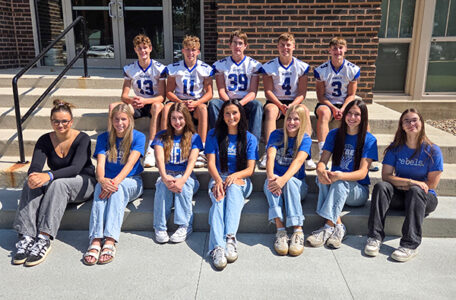Confirmed cases of Legionnaires’ disease have doubled since last Tuesday
County public health director says 12 cooling towers have been ‘remediated,’ ongoing threat is low
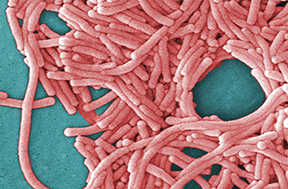
AP PHOTO This undated image made available by the Centers for Disease Control and Prevention shows a large grouping of Legionella pneumophila bacteria (Legionnaires' disease). The number of cases in Marshall County has climbed to 68 since a cluster was first announced on Thursday, Sept. 4, and one individual, Bernie Grady of Marshalltown, died on Aug. 29 after contracting the disease.
The number of Legionnaires’ disease cases in Marshall County has doubled in the last eight days, with 68 reported as of 3 p.m. on Wednesday afternoon according to the Iowa Department of Health and Human Services (HHS). That same day, Marshall County Public Health Director Sydney Grewell spoke to the T-R in a phone interview and provided an update for the first time since she and State Epidemiologist Dr. Matt Donahue addressed the Board of Supervisors at their Sept. 10 meeting.
On that date, Donahue and Grewell reported that a cooling tower, which is a device primarily found on top of large industrial facilities or apartment buildings used to remove heat from the system, pool water and allow it to evaporate, was the most likely source of the Legionnaires’ outbreak — the disease is caused by the Legionella bacteria and is spread through inhaling contaminated water droplets — and they had already collected samples from nine in north central Marshalltown with plans to conduct a 10th test later that day. The number of towers tested is now up to 12, Grewell said, and the results have not yet been returned from the State Hygienic Lab in Coralville.
“All of those cooling towers are being remediated by those establishments. We have not had any pushback from them with that remediation,” she said. “No test results have come back positive or negative at this time, so we recommended remediation regardless of the result to stop the spread of Legionella.”
The tests take a minimum of seven days, Grewell added, and the lab holds onto the samples for “an extended period of time” to ensure that nothing grows. And despite social media speculation about other potential sources of the outbreak including misting machines at grocery stores or the downtown street construction project, she said Public Health and the state HHS are still “locked in” on the cooling tower hypothesis.
“We are leaving no stone unturned, so we do appreciate those comments and calls that we have been getting,” she said. “Ourselves, the state and the CDC (Centers for Disease Control and Prevention), the outbreaks that they see like this, people do start to go down those other rabbit holes, but it is always usually the cooling towers. So we’re still focused on that.”
Grewell then addressed the recent surge in the number of cases, which has nearly quadrupled since a cluster was first announced to the public on Thursday, Sept. 4. The incubation period for Legionnaires’ is typically between two and 14 days, she noted, so individuals who were exposed on Sept. 7, for example, may not even notice their symptoms yet.
“That’s why we’re seeing those cases still coming in even though we’ve recommended that remediation process, so it may look alarming to people, like, why are we still seeing those cases when you said we’ve remediated? Those incubation periods depend on the person,” Grewell said. “Some people, it hits in a couple days, some people, it may take that full 14 days… We are expecting to see these numbers this week, and we wouldn’t be surprised to see them into next week as well just from when we’ve collected and remediated. We should start to see them slow down (after that).”
Grewell said all 12 of the sites, which have not been publicly disclosed, are considered remediated as of last week.
“They have completed those, either themselves in the beginning, and then we’ve stepped up our game to have them double make 1,000 percent sure that they’ve completed that by having a company who specializes in cleaning that (come in),” she said.
Late last week, the T-R reached out to the leaders of several large industrial businesses in Marshalltown for information on whether their sites had been tested, and Joe Carter, the President/CEO of MARSHALLTOWN Company, confirmed that he was working with Iowa Water Management Corporation on the remediation process regardless of the results.
“What we understand is that (that) means adding a chemical to the system while it’s running, let it run and circulate for several hours, and then we have to shut the system down, drain it and then refill the system. I don’t know what all that entails, but that’s what we’ve been told to do. So that’s what we’re doing,” he said. “We’ve got a standard procedure we go through. We’ve got an outside contractor who tests all that stuff, and I’m guessing that everybody else is the same way.”
Carter added that he himself had been tested for the disease, but he has been traveling over the last several weeks and hasn’t been around much recently.
As part of the investigation process, public health officials are asking not only standard questions per CDC guidelines but also more specific ones about where those infected have traveled and potentially been exposed to the contaminated water droplets that cause the disease, which is a severe form of pneumonia and got its name because of a 1976 American Legion conference at a hotel in Philadelphia where 182 people were infected and 29 died. The source is still considered to be somewhere in the north central region of Marshalltown north of the railroad tracks, which includes the downtown area.
Going forward, Marshall County Public Health and Iowa HHS are still waiting on test results and ensuring the businesses with the cooling towers are in compliance with the required remediation processes, supporting local healthcare providers and making sure that all human samples are being submitted to the State Hygienic Lab to be matched with the environmental samples collected.
“We’re still working around the clock. There’s multiple meetings during the day. Like I said, that case count, I know, is concerning for people, but it makes more sense when you think about that incubation period,” Grewell said.
A day after the outbreak was publicly announced, the Harvest Market was held on 13th Street with thousands of people attending, and the annual Oktemberfest event is still scheduled for next week, Sept. 25-27, in the downtown area.
“Like we’ve said before, the risk remains low to the public, and that’s why we’ve still continued to encourage people to not change their daily activities, including going to things like The Harvest Market, going to Oktemberfest, enjoying downtown (and) going outside, you know, things like that, because we’ve completed those remediation processes,” Grewell said. “So those people that were likely exposed a couple weeks ago or a week ago or whenever it may have been before that remediation had taken place, that threat should no longer be there.”
Cases of other respiratory viruses like COVID-19 are also currently on the rise locally.
——
Contact Robert Maharry at 641-753-6611 ext. 255 or rmaharry@timesrepublican.com.

